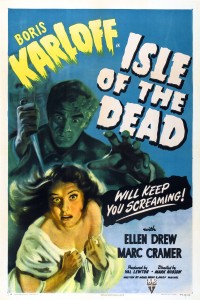Isle of the Dead (1945)
“I told you that no one could leave.”
|
Synopsis: |
|
Genres, Themes, Actors, and Directors:
Response to Peary’s Review: Peary spends the bulk of his review analyzing the film and its characters in light of Lewton’s limited but impressive oeuvre (nearly all of which are “must see” movies). He points out that “in Lewton films, when a character” (such as Karloff’s general) “loses his mind he reverts to old, superstitious ways”, and notes that the screenplay allows Lewton to “exploit his concept of man controlled by fate”. He makes an apt analogy between Drew’s character (Thea) and Simone Simon’s Irena in Lewton’s Cat People, noting that Thea, like Irena, is “not sure she doesn’t harbor evil within her” — but while Irena is immediately presented as a sympathetic character whose fate we genuinely care about, Thea (a gypsy) simply functions here as a conveniently “Othered” scapegoat (and a requisite romantic lead). Ultimately, you’re better off spending your time rewatching one of Lewton’s many other classic psychological horror flicks — though film fanatics will be probably be curious to check this one out at least once. Redeeming Qualities and Moments: Must See? Links: |



One thought on “Isle of the Dead (1945)”
I agree, not must-see.
As usual, Lewton’s unique production value impresses. However, this earnest tale of plague and superstition is strangely written and constructed and doesn’t seem to follow its own terms. What it does, unfortunately, remain true to is its talky nature. Ultimately, there’s almost nothing here that is very satisfying.